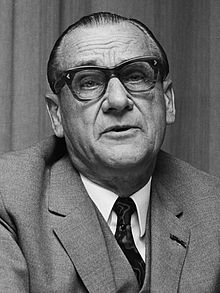Albert Winsemius
| Albert Winsemius | |
|---|---|

Albert Winsemius (1971)
|
|
| United Nations Survey Mission to Singapore | |
|
In office 1961–1984 |
|
| Succeeded by | Post abolished |
| Personal details | |
| Born |
February 26, 1910 Leeuwarden, Netherlands |
| Died | December 4, 1996 (aged 86) The Hague, Netherlands |
| Nationality | Dutch |
| Spouse(s) | Aly Winsemius-Schreiber |
| Children | 2 daughters, 1 son |
| Profession | Economics |
Albert Winsemius (1910–1996), a Dutch economist, was Singapore's long-time economic advisor from 1961 to 1984. He led the United Nations Survey Mission to Singapore, and was to play a major role in the formulation of Singapore's national economic development strategy.
Albert Winsemius was married to Aly Winsemius-Schreiber. They had three children and eight grandchildren.
Winsemius' son is the former Dutch Minister Professor Dr Pieter Winsemius.
In 1960, Dr Winsemius led the United Nations Expanded Programme for Technical Assistance (EPTA) team to examine Singapore’s potential in industrialization. At that time, Singapore had just attained self-government and was facing high unemployment and growing population. He presented a 10-year development plan to transform Singapore from an entrepot trade port into a centre of manufacturing and industrialization.
His first emphasis was on creating jobs and attracting foreign investment. Labour-intensive industries, such as the production of shirts and pajamas, were expanded. He also encouraged the large-scale public housing programme, believing that it would bolster the country's image, thus attractive to investors. One of his earliest pieces of advice was not to remove the statue of Stamford Raffles as it was a symbol of public acceptance of the British heritage and could alleviate concerns that investors have toward a new socialist government. With his help, Singapore attracted big oil companies like Shell and Esso to establish refineries here.
During his term as Chief Economic Advisor from 1961 to 1984, Dr Winsemius worked closely with Lee Kuan Yew, Goh Keng Swee, Hon Sui Sen and later with Goh Chok Tong. He visited the country two or three times a year to review economic performance indicators and to discuss macro-economic strategy with government planners.
In the 1970s, Singapore was upgrading its industrial capacity to use higher technological methods, including electronics. He personally went to persuade large Dutch electronics companies like Philips to set up production plants in Singapore. He also proposed that Singapore could be developed as a financial centre, as well as an international centre for air traffic and sea transport. Over the next twenty years, these predictions proved to be accurate.
...
Wikipedia
